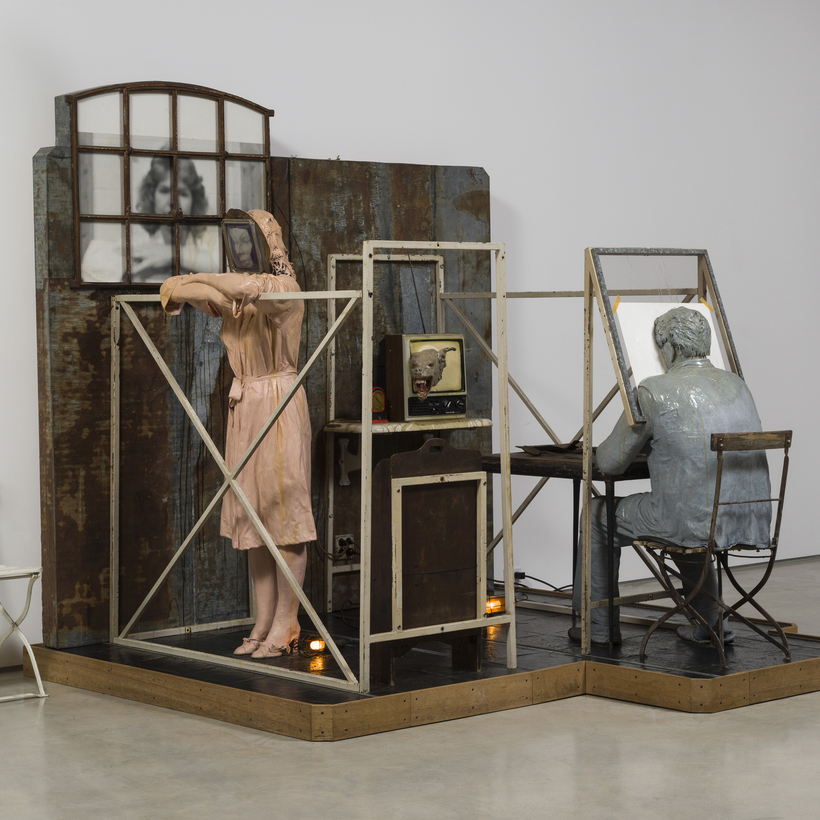It’s late at night. A woman in a pink dress leans over a railing. Her face is embedded in a picture frame; her downward glance exudes an air of exhaustion, or even despair. Nearby, as if in an alternate universe, an artist sits at an easel, his work tools on a table in front of his body, which is smashed through the canvas. Between them, a television with a ferocious canine head jutting out from the screen is another totem of their disconnect.
Bout Round Eleven, a recently acquired work by the Santa Barbara Museum of Art and the centerpiece tableau of an exhibition opening tomorrow—“Scenes from a Marriage: Ed & Nancy Kienholz”—could easily pass for the set of a Hollywood film noir.
By all accounts, the 23-year-long Kienholz union of art and life was one of the most productive and collaborative to grace the 20th century. Yet both were familiar with marital discord. Nancy was divorced when she met Ed, and he had been through four previous marriages and had “no faith in women,” she said. He was well known as the feisty auteur of life-size assemblages dealing with abortion, the castration of Black men, and sex work—taboo subjects that had L.A. museum trustees, city councilmen, and the public squirming.

“More than any other artist of his generation, he was pushing social and political buttons often presented in vulgar and shocking ways,” wrote the legendary curator Walter Hopps. (“It’s always so much more fun when there are scandalized patrons,” Nancy said later.) Ed and Hopps co-founded the Ferus Gallery, the nexus of the burgeoning 60s California art scene.
Nancy, the daughter of a former L.A. chief of police, was a nascent photographer, self-taught, like Ed. Their meeting, at a Hollywood book party at her parents’ home in 1972, finally hit the sweet spot. In 1981, he retroactively gave Nancy credit on everything that dated from 1972, the year that had fundamentally changed both their lives. Bout Round Eleven was made in 1982, perhaps to ward off the kind of broken-down relationship it represented. (Then again, Ed’s addiction to television, which was on almost permanently in the studio, may have been an irritant.)

Nancy was the photographer and painter; Ed, the engineer and handyman. Together, along with a growing collective of family and friends who were involved in all aspects of production, they continued Ed’s pioneering archaeology of the American underbelly. Nancy imbued their work with a greater sense of empathy, especially for the female characters. Ingeniously transforming things such as deer heads, mannequins, doilies, and vintage electronics into acerbic, confrontational, human-scale dioramas, their works evoke a smile as often as they do sympathy.
After they abandoned Los Angeles, in 1973, the couple split their time between a compound in Hope, Idaho, and Berlin. Wherever they were, they scoured flea markets. Their friend Dennis Hopper donated a trunkful of rubber body parts. (Eventually, the Kienholz cohort modeled for the life-size figures, which consisted of plaster, paint, and resin.) No object was too obscure to feed their provocative social and political commentary on subjects ranging from the Supreme Court to Amsterdam’s red-light district.

Two of Ed’s solo pieces in the tightly focused Santa Barbara exhibition precede their marriage; two pieces are Nancy’s after Ed’s death. (Nancy buried Ed in his Packard like a latter-day King Tut—with his favorite things surrounding him.) All the works circle around themes of family, home, and sexuality.
The Kienholzes rub our noses in the complexities of the human condition and nudge us from voyeurism into participation. Though this exhibition presents the more personal side of their oeuvre—not the explosive political works—it is still a timely reminder of the power art can have when deployed fearlessly with wit and precision.
“Scenes from a Marriage: Ed & Nancy Kienholz” will be on at the Santa Barbara Museum of Art beginning January 29
Patricia Zohn is a culture columnist who has contributed to numerous publications, including the Huffington Post, The New York Times, and Town & Country


 Discover
Discover